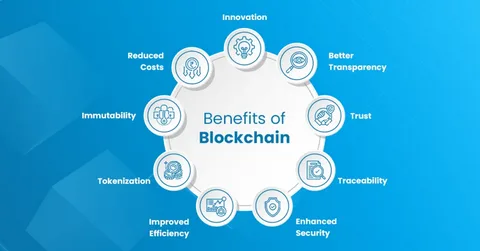Unlocking Blockchain Technology for Tomorrow

In recent years, blockchain technology has emerged from niche crypto circles into mainstream discussions across industries. What began as the underlying ledger for cryptocurrencies has blossomed into a foundational tool for secure, transparent, decentralized systems that promise to reshape everything from finance and supply chain to healthcare and governance. Yet, despite its growing adoption, many still struggle to grasp how blockchain truly works, why it matters, and where it can be applied most powerfully.
This article dives deep into the heart of blockchain technology: explaining its core architecture, exploring real-world use cases, examining benefits and challenges, and offering insights into its future direction. Along the way, we’ll weave in related terms and LSI keywords like distributed ledger, smart contracts, decentralization, cryptographic security, and digital trust — all while maintaining accessibility. Whether you’re a tech enthusiast, business leader, or curious reader, by the end, you’ll have a robust understanding of how blockchain tech is transforming the digital and physical world.
What Is Blockchain Technology
The Core Concept of Distributed Ledger
At its essence, blockchain technology is a type of distributed ledger system. Unlike a traditional database held by a central authority, blockchain records are stored across a network of computers (or nodes), each of which maintains a copy of the ledger. When a new transaction or data record is added, it must be validated by consensus before being chained onto the ledger, forming a block that links cryptographically to the prior one. This chaining creates an immutable sequence of records: once written, data cannot be altered without breaking the links to all subsequent blocks.
This structure provides tamper resistance, fault tolerance, and transparency, because any participant can audit the ledger themselves. That decentralization is a core differentiator from centralized systems.
Key Components: Blocks, Consensus, and Cryptography
To understand blockchain technology more deeply, we must break its modular structure into three essential components:
-
Blocks and Transactions
Each block contains a batch of transactions or records. Transactions are packaged into a Merkle tree structure, which allows efficient verification and integrity of data. Each block also stores a cryptographic hash of the previous block, binding the chain together. -
Consensus Mechanisms
Since multiple nodes must agree on what is valid, blockchains use consensus protocols like Proof of Work (PoW), Proof of Stake (PoS), Practical Byzantine Fault Tolerance (PBFT), or hybrid models. These protocols ensure that the network agrees on a single version of the truth while resisting malicious attacks. -
Cryptographic Security
Public-key cryptography underpins identity and transaction validation. Users sign transactions using private keys, which can be verified with public keys. This ensures authenticity, non-repudiation, and that only authorized parties can initiate transfers.
In more advanced designs, modular or layered blockchains separate responsibilities into networks for consensus, execution, and data availability, improving scalability and flexibility.
Why Blockchain Technology Matters
Building Trust in Trustless Systems
One of the paradoxical strengths of blockchain technology is its ability to foster trust without a central intermediary. Because transactions are validated across many independent nodes and secured cryptographically, users can transact with confidence—even when they don’t know or trust one another.
This introduces digital trust as a programmable property, enabling applications such as cross-border payments, decentralized finance (DeFi), tokenized assets, and more—all executed in a transparent, auditable fashion.
Enhancing Transparency and Auditability
In sectors like supply chain, healthcare, or government, transparency and audit trails matter. Blockchain technology makes it possible to log provenance, movement, changes, and access with tamper-proof records. Auditors or regulators can trace history in a verifiable way. This capability is already being applied to food traceability, pharmaceutical supply chains, and carbon credit trading.
Reducing Intermediaries and Friction
Many industries currently rely on trusted third parties—banks, escrow agents, clearing houses—that introduce cost, latency, and risk. Blockchain technology allows the creation of smart contracts—self-executing code triggered by conditions—that can automate enforcement, payment, or transfer logic without intermediaries. The result is lower fees, faster settlement, and less friction in transaction workflows.
Real-World Use Cases of Blockchain Technology
Finance and Decentralized Finance (DeFi)
The most well-known domain for blockchain is the financial sector. Cryptocurrencies like Bitcoin and Ethereum pioneered peer-to-peer value transfer. Beyond that, DeFi is now reshaping banking with lending/borrowing platforms, decentralized exchanges, yield farming, stablecoins, and algorithmic insurance systems—all implemented via smart contracts on blockchains.
These systems provide financial inclusion, permissionless access, and composable infrastructure, allowing users anywhere to tap into global financial services without traditional banking.
Supply Chain and Logistics
One of the most promising non-financial use cases is supply chain management. Blockchain technology enables tracking goods at every stage—from raw material to final sale—ensuring authenticity, preventing counterfeiting, and enabling recall tracebacks. Companies use blockchain to verify ethical sourcing, reduce fraud, and increase transparency for consumers.
Identity and Self-Sovereign Identity
Blockchain technology is also transforming identity. Traditional identity systems are centralized and vulnerable to breaches. On blockchain, self-sovereign identity allows individuals to own credentials and share them selectively. Verified attestations (from governments, institutions) can be anchored on a blockchain, enabling secure, user-controlled identity for KYC, voting, or credentialing.
Healthcare and Medical Records
In healthcare, secure, interoperable medical records are vital. Blockchain technology helps by providing a tamper-resistant, patient-centric ledger of health events. Patients—or authorized providers—can grant controlled read/write access to records, improving continuity and privacy. Audit trails further ensure accountability.
Intellectual Property & Digital Rights
Content creators, musicians, artists, and publishers are leveraging blockchain technology to manage copyrights, licensing, and royalty distribution. Tokenizing works or issuing NFTs (non-fungible tokens) allows attribution, immutable proof of ownership, and automated royalty splits via smart contracts.
Internet of Things (IoT) Integration
When devices in an IoT ecosystem need secure and autonomous coordination, blockchain can help. Smart devices can interact via blockchain-based protocols, enabling secure machine-to-machine payments, identity, event logging, and trusted coordination between nodes.
Benefits and Advantages of Blockchain Technology

Immutability and Security
Because each block is cryptographically linked, tampering with historical records is extremely difficult without consensus. This provides data integrity and immutability, ideal for auditing, security, and compliance.
Decentralisation and Resilience
Without a central authority, blockchain networks are resilient to failures or attacks on single points. The distributed nature ensures continuity and redundancy. This architecture increases fault tolerance and censorship resistance.
Transparency and Verifiability
Public or permissioned blockchains make all valid transactions visible and verifiable by participants (or controlled viewers), promoting openness and accountability.
Automation via Smart Contracts
Smart contracts enable self-executing logic that triggers when conditions are met. By embedding rules, they reduce manual intervention, disputes, and intermediaries. This automation can streamline workflows across finance, logistics, legal, and more.
Cost and Time Efficiency
By eliminating middlemen, reducing reconciliation efforts, and enabling instant settlement, blockchain technology can bring significant cost and time savings to industries burdened by friction and complex processes.
Programmability and Tokenisation
Blockchain enables programmable money, tokenisation of real assets (e.g., real estate, art, carbon credits), and composable systems (DeFi protocols, modular dApps). This flexibility opens new business models and possibilities.
Challenges and Limitations of Blockchain Technology
Scalability and Throughput
One of the biggest criticisms is that mainstream blockchains struggle with high throughput. Popular networks like Ethereum can suffer from congestion, high gas fees, and limited transactions per second. Innovations like sharding, layer-2 scaling, sidechains, and rollups aim to mitigate this—but the tradeoff between speed and decentralization remains a major design challenge.
Energy Consumption (in Some Models) Proof-of-work blockchains, such as Bitcoin, consume significant energy during mining. This raises environmental and sustainability concerns. Many newer chains adopt Proof of Stake or hybrid models to reduce energy footprints.
Interoperability
Many blockchains operate in silos, making cross-chain communication, asset transfer, and data sharing difficult. Projects like Polkadot, Cosmos, and bridges attempt to solve interoperability, but risk, security, and complexity remain.
Regulatory, Legal, and Compliance Issues
Because blockchain touches finance, identity, and data, it faces complex regulatory landscapes across jurisdictions. Questions around privacy, taxation, securities classification, and liability continue to challenge adoption, especially for public and permissionless networks.
Privacy vs Transparency
While transparency is a strength, it also poses privacy challenges. Public blockchains expose transaction data (albeit pseudonymously). Techniques like zero-knowledge proofs, differential privacy, and mixers aim to add privacy layers. In fact, combining differential privacy with blockchain is an active area of research.
User Experience and Adoption Hurdles
For mass adoption, blockchain apps must simplify key management, wallets, onboarding, and usability. The average user should not need to understand cryptographic keys or gas fees. Improving UX remains a critical barrier.
Governance and Upgrade Path
When a protocol must evolve—for bug fixes, new features, or forks—maintaining consensus among distributed stakeholders is complex. Governance models, change coordination, and conflict resolution are open challenges.
How to Implement Blockchain Technology in Practice
Choosing the Right Type: Public, Private, Permissioned
A first architectural decision is the type of blockchain:
-
Public, permissionless chains (e.g., Ethereum, Bitcoin): open to anyone, fully decentralised.
-
Permissioned or private chains: restricted node membership (e.g, for enterprises or consortia) to preserve control, privacy, and performance.
-
Hybrid models: combine public and private elements (e.,g. anchoring data to a public chain for audit while storing sensitive data off-chain).
Defining Use Case and Value Proposition
Not every problem needs blockchain. A good project begins by defining a use case where decentralisation, immutability, or trustless interactions offer a real advantage over existing systems. For instance, tracking provenance across multiple independent parties or enabling programmable escrow would justify blockchain technology.
Selecting a Blockchain Platform or Framework
Many platforms support smart contract development (e.g., Ethereum, Hyperledger Fabric, Polkadot, Solana, Corda). Choose one based on consensus model, scalability, tooling, ecosystem, security track record, and community support.
Designing Smart Contracts and Tokens
Smart contracts must be secure and audited. Token economics (tokenomics) must align incentives for network participants. Formal verification, code audits, and best practices are essential to avoid vulnerabilities (e.g, reentrancy, integer overflow).
Off-Chain vs On-Chain Decisions
Not all data belongs on-chain. For scalability and cost reasons, many systems combine on-chain logic with off-chain storage or computation (via oracles, sidechains, IPFS, or databases). Determining which data to anchor on-chain and which to handle off-chain is a key design decision.
Governance, Upgradability, and Maintenance
Plan governance frameworks early: who can update contracts, who can resolve disputes, and how consensus is achieved. Use proxies, versioning, and modular architectures to allow safe upgrades.
Security, Audits, and Testing
Security is non-negotiable. Conduct thorough testing, audits, bug bounties, and simulations before going live. The value locked in many blockchain systems makes them targets for malicious actors.
Integration and Adoption Strategy
Finally, integrate blockchain components with legacy systems, user-facing apps, APIs, wallets, and identity systems. Foster adoption via UX, developer tooling, and incentives. Engage with communities to bootstrap usage.
The SEO Perspective: Why Blockchain Websites Need Visibility

While our primary focus is education and technology, an effective blockchain project must also be discoverable. That means applying SEO strategies tailored to the unique context of the blockchain and crypto landscape. Conventional SEO alone is not always enough because search engines often scrutinize crypto content heavily to prevent scams, misrepresentation, or misinformation.
Some key SEO considerations in the blockchain space:
-
Target long-tail, conversational keywords rather than trying to dominate generic terms like “blockchain technology” (though you should still include that focus keyword).
-
Prioritize user intent and clarity—explain terms, avoid jargon, guide beginner-to-advanced readers. Optimize on-page SEO (title tags, meta descriptions, headers, alt text, internal linking) with crypto context in mind.
-
Build authoritative backlinks from reputable crypto publications, academic research, or industry consortia
-
Improve technical SEO: mobile optimization, page speed, clean site architecture, structured data.
-
Leverage decentralized content networks, community forums, and crypto blogs to amplify reach (#Web3 SEO).
-
Watch for regulatory constraints, content restrictions, and algorithmic treatment of crypto content.
By blending blockchain engineering with strategic content and SEO, projects can reach a wider, more engaged audience and amplify adoption.
Future Trends and Innovations in Blockchain Technology
Layer-2 Scaling and Rollups
Scaling solutions are among the most active areas of development. Layer-2 techniques like Optimistic Rollups, ZK (zero-knowledge) Rollups, and sidechains allow high throughput while preserving security links to the main chain.
Interoperability and Cross-Chain Bridges
The ability for different blockchains to communicate—sharing assets, data, and logic—is becoming essential. Protocols like Polkadot, Cosmos, and bridges aim to break the siloed nature of current systems.
Privacy Enhancements and Zero-Knowledge Proofs
Privacy is a key frontier. Zero-knowledge proofs (e.g., zk-SNARKs, zk-STARKs) allow one party to prove a statement without revealing the underlying data. Integrating such schemes offers confidentiality with verifiability. Advances in combining differential privacy with blockchain also illustrate deep research directions.
On-Chain Governance and DAOs
Decentralized Autonomous Organizations (DAOs) allow token holders to vote on protocol changes, manage treasury, or operate projects without central management. More sophisticated governance models (quadratic voting, reputation systems) are emerging.
Integration with AI, IoT, and Edge Computing
Blockchain technology will increasingly integrate with artificial intelligence, decentralized identity, IoT, and edge computing systems. For example, devices may autonomously transact, share data, or make decisions on blockchain networks.
Generative Engine Optimization (GEO) & AI Search
As AI-driven search and content generation tools (e.g, ChatGPT, Gemini) become common, optimizing content for generative engines (GEO) will complement traditional SEO. Blockchain projects will need strategies to attract citation and answer inclusion in AI responses.
Decentralized Storage and Compute
To support scalable dApps, blockchains will increasingly pair with decentralized storage (IPFS, Arweave) and off-chain compute systems. This allows heavy computation and data to be handled off-chain, with verifiable anchors on-chain.
Practical Tips for Blockchain Project Builders
-
Start small: pilot minimal proofs-of-concept before scaling up.
-
Prioritize security from day one: audits, formal methods, and best practices are essential.
-
Focus on UX: abstract away cryptographic complexity so users don’t need to be experts.
-
Design incentives: align tokenomics and governance so that participants are motivated.
-
Document everything: whitepapers, audit reports, SDKs, APIs help adoption.
-
Engage community: open source, developer grants, hackathons, social media, GitHub.
-
Stay compliant: monitor evolving regulations, especially for financial or identity use cases.
-
Iterate: adopt modular architectures that allow upgrades and replacement of components.
-
Measure success: track usage, retention, performance, security incidents, and SEO metrics.
-
Stay informed: follow blockchain research, standards bodies, and academic surveys.
Also Read: What Is Blockchain Technology? A Simple Deep Guide
Conclusion
Blockchain technology represents one of the most transformative advances of the digital age. Far more than just a platform for cryptocurrency, it offers a new paradigm of trustless systems, decentralized governance, and programmable value. Across finance, supply chain, identity, healthcare, and art, real-world applications are already taking hold.
Yet, blockchain is not without challenges. Scalability, privacy, interoperability, governance, and regulatory uncertainty remain real obstacles. Success lies in intelligent design: knowing when to use blockchain, how to combine on-chain and off-chain systems, and how to build secure, usable applications.
From a visibility standpoint, projects must also think about SEO, discoverability, and content strategy—ensuring that their innovations don’t stay hidden in the shadows. By combining deep technical implementation with strategic content, blockchain solutions can scale, attract users, and drive adoption.
This article has mapped out the architecture, benefits, limitations, use cases, implementation guidance, SEO considerations, and future trends of blockchain technology. As the blockchain space evolves, staying curious, adaptive, and rigorous will be your greatest assets.
FAQs
Q: What is the difference between blockchain technology and a traditional database?
A traditional database is centralized and editable by administrators. In contrast, blockchain technology uses a distributed ledger across many nodes, where transactions are cryptographically linked and immutable once validated. This decentralization and consensus mechanism differentiate it from conventional storage systems.
Q: How secure is blockchain technology? Can it be hacked?
Blockchain is very secure when properly designed. Cryptography, consensus mechanisms, and decentralized architecture make tampering extremely difficult. However, vulnerabilities can arise via smart contract bugs, weak key management, or programming errors. That’s why audits, formal verification, and robust testing are critical.
Q: What kinds of applications are best suited to blockchain deployment?
Use cases that benefit from decentralization, trustless interaction, auditability, and removal of intermediaries are ideal. Examples include DeFi, cross-party supply chain tracking, decentralized identity, digital rights management, and cross-border settlement. If your system relies on a single authority or has minimal need for trust between parties, blockchain may not be necessary.
Q: How does blockchain technology scale to support many users and transactions?
Scalability techniques include layer-2 solutions (rollups, state channels), sharding, sidechains, and modular architectures. These approaches move heavy computation off the main chain or partition work to parallel shards, preserving decentralization while increasing throughput.
Q: What is the future of blockchain technology?
The future likely involves greater interoperability, privacy enhancements (e.g, zero-knowledge proofs), AI and IoT integration, richer on-chain governance (DAOs), and improved developer tools. As generative search and AI-based indexing rise, blockchain content and protocols may also adapt to optimize for visibility in AI systems.




